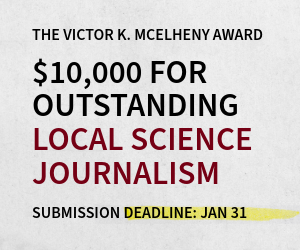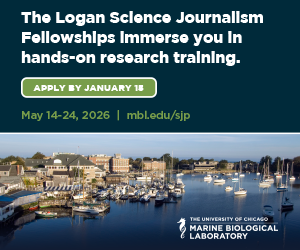NASW members are invited to apply for travel grants to attend the Lindau Nobel Laureate Meeting June 28-July 3 in Lindau, Germany. Apply by March 1, 2015, for the opportunity to connect with 60+ Nobel Laureates in physiology & medicine, physics, and chemistry and over 600 young researchers from 80 countries.
Science writing news
The NASW Education Committee is again sponsoring its annual mentoring program during the American Association for the Advancement of Science meeting in San Jose, Feb. 12-16. We will pair mentors with students in graduate science writing programs or with undergraduates who have demonstrated a serious interest in science journalism. Use the "read more" link to learn more and apply as either a mentor or a student.
How do you find an agent? What material should you send? Those questions on NASW-Books generated this recent exchange and tips from NASW authors.
In the U.S. today, remains of some 40,000 individuals have yet to be identified. In The Skeleton Crew, Deborah Halber explores a subculture of amateur detectives, who strive to solve cold cases. Many do their legwork on the Internet. As one reviewer noted, it’s DIY CSI.
Every school day, students at Carlsbad High tune in their classroom televisions to a news show produced by its award-winning broadcast journalism program. But no one expected the kind of attention that has lately muzzled one of its most acclaimed works — a short documentary produced by an extracurricular offshoot of the program. The movie, “Invisible Threat,” bills itself as a report on “the science of disease and the risks facing a society that is under-vaccinated.”
Starting August 30, at the request of his British publisher, David Quammen pulled information on the Ebola virus from his 2012 book, SPILLOVER, edited and rearranged it, and added a new introduction and epilogue to address 2014 events. The result is a concise Ebola information resource for citizens, media professionals, and public officials. “I hadn’t imagined, months earlier,” Quammen writes, “that it was physically possible to shape, print, and publish a book so quickly.”
NASW members are reminded that the IRS takes a dim view of freelance writers and other self-employed individuals who miss deadlines for filing federal tax returns or the due dates for making estimated tax payments. Miss just one, says the IRS, and it might exact a sizable, nondeductible penalty, which is based on the agency’s current interest rate for back taxes.
Science writers take a “show me the numbers” approach when tackling a tough topic. So, organizers of Solutions Summit 2014: Women in Science Writing came armed with their own data to back up recent concerns that gender bias, inequity, and sexual harassment are still holding women back.
Science writers have always had to cope with angry readers or industries who don’t like their stories. Responding to criticism is part of the job. But these days journalists, PIOs, and scientists find themselves facing personal attacks and even death threats. Just writing about global warming, GMOs, or vaccines can trigger personal attacks or lawsuits. Women are also subjected to harassment, stalking, threats of rape, and barrages of pornography.



